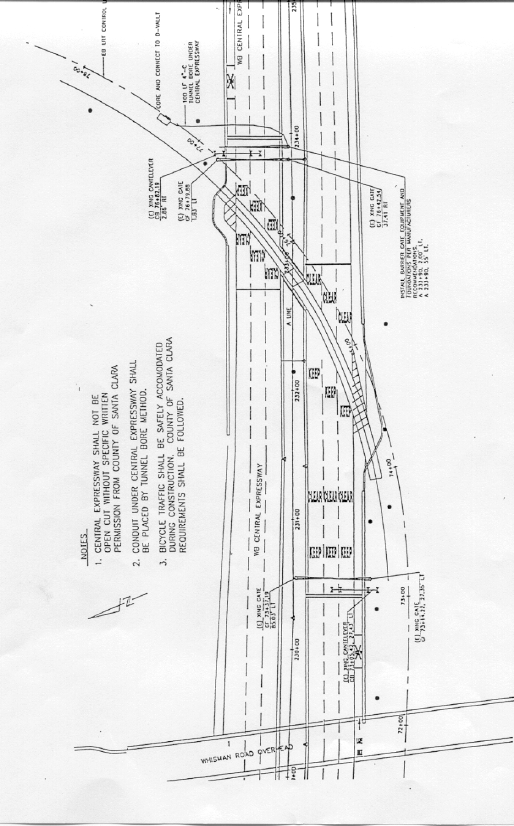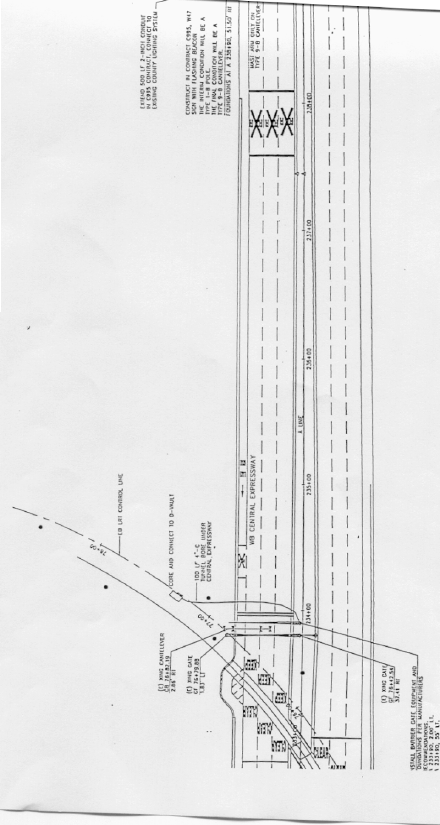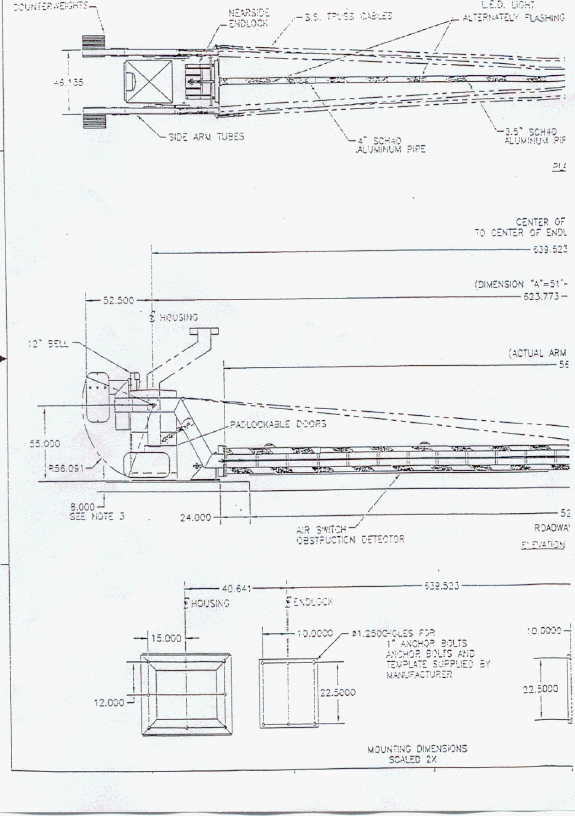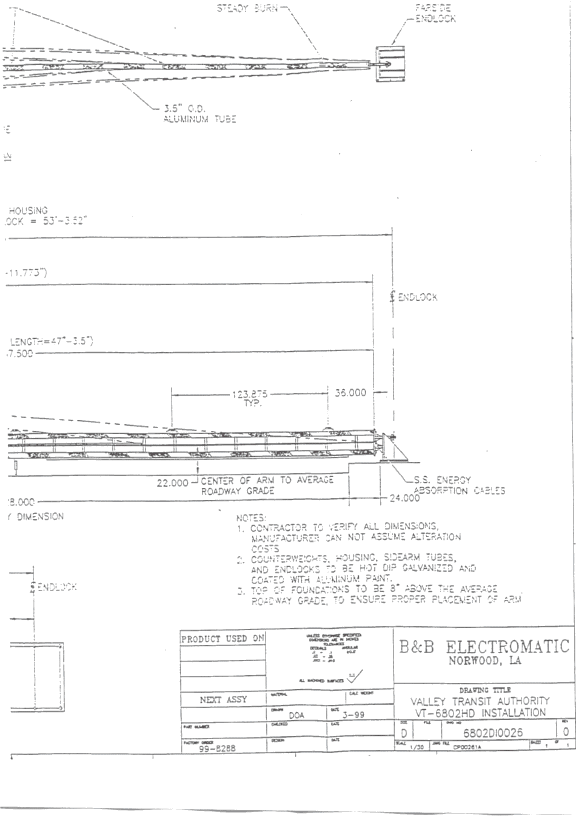Conclusions of Law
1. The application is uncontested and a public hearing is not necessary.
2. The application should be granted as set forth in the following order.
ORDER
IT IS ORDERED that:
1. The Santa Clara County Valley Transportation Authority (VTA) is authorized to modify the at-grade crossing of Central Expressway (Crossing 001E-36.90-C) in the City of Mountain View (City), County of Santa Clara (County), as shown on the plans attached to the application, to be identified as Crossing 082B-13.08.
2. The crossing shall be fitted with two (2) Standard No. 9 automatic gate type signals and two (2) Standard No. 9-A automatic gate type signals with cantilever, as specified in General Order (GO) 75-C.
3. The crossing shall be fitted with one (1) positive-barrier gate for the westbound approach on Central Expressway, on a test/demonstration basis.
4. Installation of the positive-barrier gate system is authorized on a trial/demonstration basis for a period of one (1) year following the date of this Decision. If, at any time during this test period, the system is deemed insufficient, inadequate, or unsafe, it shall be removed. Subsequently, VTA shall propose mitigating measures to alleviate hazards associated with the limited sight-triangle in order to maintain operations across Central Expressway.
5. VTA shall submit a 6-Month Preliminary Evaluation Report, 1-Year Final Report, and 1-Month Post Incident Reports to the Commission's Rail Safety and Carriers Division (RSCD), Rail Crossings Engineering Section (RCE) as defined in Appendix C, Testing & Evaluation, of this Decision.
6. Upon review of the 6-Month, 1-Year, and Post Incident Reports, RCE shall make recommendation to the Commission regarding the continued use of the positive-barrier gate system.
7. Clearances shall be in accordance with General Order (GO) 26-D.
8. Walkways shall conform to GO 118. Walkways adjacent to any trackage subject to rail operations shall be maintained free of obstructions and shall be promptly restored to their original condition in the event of damage during construction.
9. Construction and maintenance costs shall be borne in accordance with an agreement entered into between parties. A copy of the agreement shall be filed by the VTA with the Commission's Rail Safety and Carriers Division/Rail Crossing Engineering Section prior to commencing construction. Should parties fail to agree, the Commission will apportion the costs of construction and maintenance by further order.
10. The VTA shall file the final construction plans, as approved by City, County, and the Union Pacific Railroad, with the RSCD/RCE prior to commencing construction.
11. Within thirty (30) days after completion of the work under this order, the VTA shall advise the RCE staff in writing that the authorized work was completed.
12. This authorization shall expire if not exercised within three (3) years unless time is extended or if the above conditions are not complied with. Authorization may be revoked or modified if public convenience, necessity, or safety so require.
13. The application is granted as set forth above.
14. Application 94-12-018 is closed.
This order becomes effective thirty (30) days from today.
Dated January 06, 2000 at San Francisco, California.
RICHARD A. BILAS President |
HENRY M. DUQUE |
JOSIAH L. NEEPER |
CARL W. WOOD |
Commissioners |
I abstain
/s/ LORETTA M. LYNCH
Commissioner
 APPENDIX A
APPENDIX A
 APPENDIX A (Continued)
APPENDIX A (Continued)
APPENDIX B
DESCRIPTION & DRAWING OF THE POSITIVE-BARRIER GATE
Safety Barrier Gate 1Description
(as described in Exhibit L1 of the Amendment to A.94-12-018)
B&B Electromatic in Norwood, Louisiana manufactures the movable safety barrier gate. The safety barrier gate arm is deployed using a vertical pivot action, with a positive locking device at each end of the arm to secure the gate across the roadway. The locking device at the far end of the gate arm is located behind the roadway shoulder. It is mounted in a concrete foundation.
Energy absorption steel cables internal to the gate arm tubing enable the B&B safety barrier gate to arrest a vehicle. The purpose of the safety barrier gate is to stop the vehicle prior to the railroad tracks, thus preventing a collision between the vehicle and the train.
The safety barrier is a moveable gate intended to close a roadway temporarily at a railroad crossing. It consists of a housing containing the electro-mechanical components that lower and raise the arm. The arm is comprised of three 19-mm diameter steel cables. The top and bottom cables are set inside two 90-mm diameter Schedule 40 aluminum tubes which are connected by twenty-two 380 mm long rectangular connectors welded vertically between the upper and lower tubes. Three separate 8.5 diameter cables are threaded through each of these vertical connectors t o join the upper, middle and lower energy absorbing 19-mm cables to hold them in place in a crash.
When the gate is in its closed position, the cables and aluminum framework fit into two endlock assemblies that are bolted to concrete foundations on both sides of the roadway. The center of the lowest tube is 375 mm above the pavement surface and the center of the top tube is 730 mm above ground when the barrier is down. Total gate width is 13.7 meters.
 APPENDIX B
APPENDIX B
APPENDIX B (Continued)

APPENDIX C
BARRIER GATE OPERATIONS & MAINTENANCE, TESTING & EVALUATION
(as described in Exhibit L1 of the Amendment to A.98-12-018)
Operations & Maintenance
The safety barrier gate will begin its downward cycle at the same time as the lights begin to flash on the conventional railroad gates. The gate will be down in 17 seconds from the initial descent. The safety barrier gate will be activated in the same manner as the conventional crossing gate, using fail safe relays and the battery backup.
If the safety barrier gate should be struck by a vehicle and be damaged, VTA maintenance staff will be dispatched to the Central Expressway crossing. They will clean up the broken gate and vehicle components, leaving the conventional railroad gate to provide safety at the grade crossing. The immediate goal of the maintenance staff is to clear the roadway of debris, allowing motorists to proceed safely along Central Expressway.
When train operators are advised of, or observe, broken crossing gates (including the safety barrier gate), their trains must be stopped prior to the grade crossing. An audible horn signal must be given, and the train shall proceed when it is safe to do so (VTA SOP #3.5).
During light activity for the roadway and LRT (weekends and late evenings), the maintenance crew will install the spare safety barrier gate. Flagmen will be present to guide motorists through the intersection. The new safety barrier gate will be replaced within five working days of the destruction of the original safety barrier gate. VTA will order a spare safety barrier gate and store it in San Jose at a VTA storage facility, available as a replacement if required.
If the traditional crossing gate is broken, VTA maintenance will follow existing broken gate procedures which specify that gate debris will be removed, a flagman will be immediately dispatched to the intersection, and the crossing gate repaired as soon as possible.
APPENDIX C, (continued)
Testing & Evaluation
Once the advance warning sign, the safety barrier gate and the crossing traffic control devices are installed, it will be important to evaluate motorist reaction and behavior at this grade crossing. Motorists are accustomed to railroad gates at railroad crossings. Risky behavior of going under or around gates to "beat the train" is well documented. However, documentation does not exist on driver reaction to barrier gates.
The evaluation will focus on the change in driver behavior resulting from the installation of the safety barrier gate system. It will measure the effectiveness of the gate in reducing the number of safety violations (near misses) occurring after the grade crossing warning signals are activated.
In addition, signal maintainer's concerns will be evaluated, interviews of LRT employees and motorists will be conducted, and movements observed on video. In the event that a collision occurs between a vehicle and the barrier gate, a detailed evaluation of all aspects of the collision, including the clean-up and replacement of the damaged gate arm, will be provided.
Videos will be taken of the westbound approach to the Central Expressway crossing. The important observation will be to evaluate their reaction to the advance sign, i.e. speed reduction, and to the barrier itself. In addition, it will be important to record any intrusion into the safety barrier.
6-Month Preliminary Evaluation Report (due six months after installation)
A six-month "Preliminary Evaluation Report" will be prepared. This report will evaluate progress to date, identify problem areas, problem solution, and reactions of LRT employees and motorists.
1-Year Final Report (due 1 year after installation)
The trial installation will be in effect for a period of one year from the date of installation into the ground. After one full year of operation, a Final Evaluation Report will be prepared.
1-Month Post Incident Report (due 1 month after each intrusion)
If there is an intrusion into the safety barrier gate, an analysis will be conducted on this event and submitted to the CPUC within one month of its occurrence. This analysis will evaluate the effects of the intrusion into the gate in the following areas: disruption to vehicular traffic, disruption to LRT service, flagging operations, severity of any injuries sustained, timing of the accident, arrival of clean-up crew and the clean-up process, installation of the replacement gate, etc.
NOTE: If at any time, the positive-barrier gate system is deemed insufficient, inadequate, or unsafe, and subsequently removed from operation, VTA shall mitigate hazards associated with the limited sight-triangle in order to maintain operations across Central Expressway.


